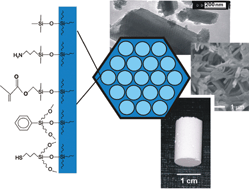Simultaneous drying and chemical modification of hierarchically organized silica monoliths with organofunctional silanes
Abstract
Large, low density

- This article is part of the themed collection: Functional hybrid materials
* Corresponding authors
a Institute of Materials Chemistry, Vienna University of Technology, Vienna, Austria
b Institute of Materials Physics, University of Vienna, Vienna, Austria
c
Inorganic Chemistry I, University of Ulm, Albert-Einstein-Allee 11, Ulm, Germany
E-mail:
nicola.huesing@uni-ulm.de
Fax: +49 731 5022733
Tel: +49 731 5022730
Large, low density

 Please wait while we load your content...
Something went wrong. Try again?
Please wait while we load your content...
Something went wrong. Try again?
D. Brandhuber, H. Peterlik and N. Hüsing, J. Mater. Chem., 2005, 15, 3896 DOI: 10.1039/B505976C
To request permission to reproduce material from this article, please go to the Copyright Clearance Center request page.
If you are an author contributing to an RSC publication, you do not need to request permission provided correct acknowledgement is given.
If you are the author of this article, you do not need to request permission to reproduce figures and diagrams provided correct acknowledgement is given. If you want to reproduce the whole article in a third-party publication (excluding your thesis/dissertation for which permission is not required) please go to the Copyright Clearance Center request page.
Read more about how to correctly acknowledge RSC content.
 Fetching data from CrossRef.
Fetching data from CrossRef.
This may take some time to load.
Loading related content
